 |
| Nav passage plan |
This passage started with excellent weather in 15-20 kts of breeze but as we neared the Channel de Four the wind increased and headed us (wind on the nose). The passage through the 20 mile channel was the most challenging so far with 45kts on the nose (bow) with wind against tide and a cross swell through the channel! Unfortunately, there was not enough room to sail through this narrow channel with the wind dead on the nose so we had to motor-sail with short tacks straight into very rough seas (classic wind against tide producing short steep seaway) for the last 7 hrs to get through the channel - literally just crawling our way south. John thought we may have to bail and head back but we finally turned East into the Brest port entrance- just before the tide turned and pushed us back out the channel!! Phew!!!
Our sailing log recorded a 204NM passage over 34 hours with five hours at Force 8, technically called 'a fresh gale' with winds up to 40kts.
 |
| Hard to spot this fort |
 |
| So many to choose from |
 After two days at anchor to recover we then moved to the Marina du Château in Brest. Of interest was stepping ashore and seeing the walk of fame at the marina for the Jules Verne trophy winners including Peter Blake and Robyn Knox-Johnson for their record circumnavigation of the world in 74 days, 22hrs, 17m, 22 secs in 1994. If you are interested see the link: http://en.wikipedia.org/wiki/Jules_Verne_Trophy
After two days at anchor to recover we then moved to the Marina du Château in Brest. Of interest was stepping ashore and seeing the walk of fame at the marina for the Jules Verne trophy winners including Peter Blake and Robyn Knox-Johnson for their record circumnavigation of the world in 74 days, 22hrs, 17m, 22 secs in 1994. If you are interested see the link: http://en.wikipedia.org/wiki/Jules_Verne_Trophy |
| Brest Castle behind Marina du Château |

After seven days in Brest (waiting for weather) we have had plenty of time for walking around, visiting the Brest Castle and Maritime Museum, catching up on domestics, enjoying the baguettes and pastries, and attempting to find a local red wine that equals the Australian reds. While we have appreciated the French fashion style we dislike the dog poo - taking a bag and cleaning up any mess seems a foreign concept here.

So far France has the record for Custom Officer's visiting Sabbaticus - five turned up on our third day to visit. Thankfully they did not come onboard and only required us to present our passports for a stamp in their office. The marina had previously called Customs for us and confirmed we did not need to visit them. Maybe it was a case of 'lost in translation'.
We can't miss the opportunity for some military history. This photo shows a German Navy Seehund Midget Submarine which were built in 1944 and had a crew of two with average mission length of 7-8 days. At the end of WW2 the French Navy found some abandoned midgets and salvaged four. This small French fleet conducted 858 missions before decommissioning in 1953.
We are now both keen to get moving again and cross the Bay of Biscay. The forecast is favourable for Mon with light winds so our next stop is hopefully La Coruña in Spain.

























